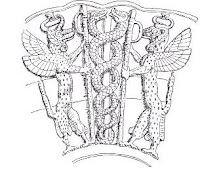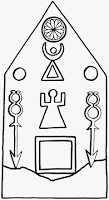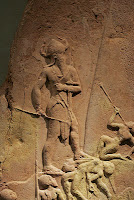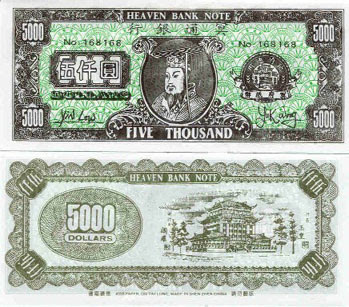Before Tertius...
Carthage, probably between 400-200 BCE, and this stone.
First thing, it looks like a boundary stone to me because it was usual for Mesopotamian boundary stones to be decorated with a symbol representing the sun, the moon and Venus. The sun symbol -which looks like a section through an orange- and the moon, are easy to see.
The Goddess Tanit is represented by the triangle, and upright arms figure. Her original name had been Inanna (Via Akadian: Ishtar, to Astarte, to eventually Tanit). But by now she had become a Goddess in her own right, the stories concerning her had changed though remaining recognisable.
At a guess, the rectangle represents dominion over the land; a symbol meaning *all*, but that's a really weak guess and based entirely on intuition.
It was the Omega and the arrow symbol that really caught my eye.
At first I thought that the Omega on the top of the arrows, again from Akadian look a little like the symbol used to represent the birthing hut -and so represented rebirth. Whilst the arrows may represent Meslemtea/ Nergal the consort of the Goddess of the underworld (Nergal had seven plague demons which, by the time of The Iliad, had become the plague arrows of Apollo).
The whole thing (in relation to the Tophet...) made me see a symbol as representing death as a pathway into a new life. If the Carthaginians did indeed sacrifice their own children in times of dire need, the arrow + Omega may make the poor parents feel a little better...

Hermes carries a similar symbol, the kerykeion, it is a heralds staff, which he carries in his left hand. This symbol is also known as the caduceus. The Iliad describes Hermes as using it to open and close the eyes of mortals, he makes us sleep and thus brings us to the borders of death.
Hermes as guider of souls, thus it is linked to death and the journey through the underworld.
Hermes, is a god of boundaries. The name for a boundary stone: a herm could be the origin of his name, and the sacred boundary-marker or road-altar, has been dedicated to Hermes since ancient times.
But a herm is also an upright stone surrounded at its base by a heap of smaller stones; not so different from Hursag meaning hill, and Ninhursag the queen of the stony ground (the Lady who gives birth to all the wild things) .
 Her omega symbol is known to appear on some Mesopotamian boundary stones. The image here comes from a truly beautiful Kudurra, see http://en.wikipedia.org/wiki/Kudurru for more information and full sized image.
Her omega symbol is known to appear on some Mesopotamian boundary stones. The image here comes from a truly beautiful Kudurra, see http://en.wikipedia.org/wiki/Kudurru for more information and full sized image.
The snake symbol in connection with the caduceus is all Greek. Serpents appear on Kassite (Mesopotamian) boundary stones, but mainly seem to represent the Kur, for they are at the bottom end of the stone, underground.
More as a force that will carry one away, than as a guardian.
Ideas spread, meet and create new symbols.Hermes and Ninhursag both have a heap of stones connection.
And so Ninhursag's omega becomes Hermes' snakes?
 This Greek early 5th century B.C, upper part of caduceus (carried by Hermes) shows the snakes perfectly.
This Greek early 5th century B.C, upper part of caduceus (carried by Hermes) shows the snakes perfectly.
This one can be seen at the Dallas museum.
But what do the snakes mean?
There is a link in Greek mythological thinking, between the snake and the uncanny and fearful. The snake signifies death and life (not necessarily re-birth).
The daughters of Cecrops are killed when they open a kiste given to them by Athena. They see the snake child (Ericthonius) within and panic, falling to their deaths over the north face of the Acropolis.
The serpentine appearance of the spinal cord led to a semi-rational belief that this part of the dead could be transformed into a living snake (see Burkert, Greek Religion; page 195) .
The death-snake was a convenient and almost omnipresent motif in Greek, Bronze Age vessels according to Burkert. But its meaning is not explained, as Burkert points out, most of what we know about Greek funerary rites come from plays, from theater scenes, and it was taken for granted that people knew what was customary and so there was no need to write out specific meanings in detail.
Perhaps it was observed that after funeral libations had been made; the wine spilt and offerings left at the grave, a snake may come to lick at the left-overs and then vanish as quickly as it had come...
Hermes too has a connection to death and the Underworld, he was the god who led the soul to the river that separated life from death. In the play Alcestis (by Euripides) Death tells us that is his role simply to cut a piece of hair from the person destined to die.
Death is a servant of fate and Death carries a sword for this task. Then it is Hermes who leads the soul over the boundary between life and death. A role latter taken by Dionysos as a more Orphic version of the Mysteries becomes current.
It makes sense to interpret the river motif as the sensation of dying, of being carried away by the woeful river or the river of ordeals: Idkurra, (in Sumerian myth). This contrasts with the calm and terrible image of the boatman in Greek myth...
So back to snakes- not forgetting that The Kur was sometimes portrayed as serpentine and able to control the flow of water.
The motif of serpents around a staff brings to mind Ningishzida.
Ningishzida is called (in this copy and paste of Google) "messenger" of the "Earth Mother".
It is the oldest image of snakes coiling around an axial pole and it is tempting to project meanings backward (Hermes is messenger to the gods, he has a stick with two snakes, so any other Babylonian deity with serpents around a pole must be a messenger!) rather than to look at myths from that specific time period.
 This image of the double serpent is said to represent Ningishazida. It came from the royal libation cup of King Gudea of Lagash (Sumer), 2000 BC. The temple of Ningishzida was located at Lagash. And the cup came with an inscription; it was meant as a long life gift. Thousands of years latter people put two and two together and see the double serpent as a symbol of healing, or rejuvenation.
This image of the double serpent is said to represent Ningishazida. It came from the royal libation cup of King Gudea of Lagash (Sumer), 2000 BC. The temple of Ningishzida was located at Lagash. And the cup came with an inscription; it was meant as a long life gift. Thousands of years latter people put two and two together and see the double serpent as a symbol of healing, or rejuvenation.
Granted...that is what it meant in the Epic of Gilgamesh.
The main story concerning Ningishzida (whose name, translated by Thorkild Jacobsen is Lord of the Good Tree) was to accomplish the death of the daylight.
In the Adapa myth he is one of two guardians, guarding the gates of Heaven.
He, like his fellow gatekeeper Dumuzi were originally mortal, but by facing the ordeal of the underworld, both would attain a godly status. He reminds me a little of Zalmoxis, a Thracian deity described by Herodotus.
Most people, or Google anyway- but not me -prefer to place Ningishzida guarding the gates of the underworld.
If the snakes are not about rejuvenation, how about Ningishazida's snakes as lightning?
Lord of the Good tree,
Lord of the lightning struck tree?
Adad, or the Canaanite Hadad are regarded as the lightning gods and it is possible that Ningishazida's serpents are closer to the Kur, dangerous primordial forces.
Lightning begins to fit...
But that Central image of a pole, serpents and perhaps the world tree is hard to read.
All I can think of is Norse myth...

Meanwhile on earth, a pair of bronze serpents flanked each of the four doorways of the temple of E.sagila ( a temple dedicated to Marduk), the serpents could represent trophies and relics of the primeval battle between Marduk and Tiamat because the shrine Esagil and the city Babylon were situated at the middle of the world created from the corpse of Tiamat, a serpentine dragon, by Marduk.Again the dominion over primordial forces...
 Moving on a thousand years, the coin in this picture was minted on Skiathos in the 4th century BC. On one side there was a picture of the god Hermes, and on the other his staff of snakes.
Moving on a thousand years, the coin in this picture was minted on Skiathos in the 4th century BC. On one side there was a picture of the god Hermes, and on the other his staff of snakes.
Now I see where the alchemical symbol for Mercury comes from!
The link between the caduceus and doctors.
The god of healing is Asclepius, latter famed and then punished by Zeus, for restoring life to the almost dead.
As someone once said,
Description of Greece:
The serpent is a reminder that Asclepius himself escaped death. Hermes rescued the god of healing from his mother's womb as she lay on the funeral pyre, because it was his role to lead the soul. Hermes chose not to lead her away...
Asclepius has the stick, he has the snake; but he has only one snake not two.
The idea of the serpent as a symbol for rejuvenation is found in The Epic of Gilgamesh, but the symbol doesn't seem to be used in art that way then or now (except for in medicine). Lucius Annaeus Cornutus, a Stoic philosopher, 60 AD described the serpent as a symbol for Asclepius and medicine in general because the serpent sheds its skin
And there I stop.
Time to return to John Dee, and the last of his three diaries (well the last of what I've been able to find of his diaries.).
This stele comes from the Tophet in Carthage (today Tunisia) Such grave markers were set up over burial urns for small children and animals which had been sacrificed to the goddess Tanit and her consort Baal Hammon.
Canaanite symbolism: sun,crescent moon and triangle; the goddess below. It is at The British Museum.
First thing, it looks like a boundary stone to me because it was usual for Mesopotamian boundary stones to be decorated with a symbol representing the sun, the moon and Venus. The sun symbol -which looks like a section through an orange- and the moon, are easy to see.
The Goddess Tanit is represented by the triangle, and upright arms figure. Her original name had been Inanna (Via Akadian: Ishtar, to Astarte, to eventually Tanit). But by now she had become a Goddess in her own right, the stories concerning her had changed though remaining recognisable.
At a guess, the rectangle represents dominion over the land; a symbol meaning *all*, but that's a really weak guess and based entirely on intuition.
It was the Omega and the arrow symbol that really caught my eye.
At first I thought that the Omega on the top of the arrows, again from Akadian look a little like the symbol used to represent the birthing hut -and so represented rebirth. Whilst the arrows may represent Meslemtea/ Nergal the consort of the Goddess of the underworld (Nergal had seven plague demons which, by the time of The Iliad, had become the plague arrows of Apollo).
The whole thing (in relation to the Tophet...) made me see a symbol as representing death as a pathway into a new life. If the Carthaginians did indeed sacrifice their own children in times of dire need, the arrow + Omega may make the poor parents feel a little better...
Hermes carries a similar symbol, the kerykeion, it is a heralds staff, which he carries in his left hand. This symbol is also known as the caduceus. The Iliad describes Hermes as using it to open and close the eyes of mortals, he makes us sleep and thus brings us to the borders of death.
Hermes as guider of souls, thus it is linked to death and the journey through the underworld.
Hermes, is a god of boundaries. The name for a boundary stone: a herm could be the origin of his name, and the sacred boundary-marker or road-altar, has been dedicated to Hermes since ancient times.
But a herm is also an upright stone surrounded at its base by a heap of smaller stones; not so different from Hursag meaning hill, and Ninhursag the queen of the stony ground (the Lady who gives birth to all the wild things) .
The snake symbol in connection with the caduceus is all Greek. Serpents appear on Kassite (Mesopotamian) boundary stones, but mainly seem to represent the Kur, for they are at the bottom end of the stone, underground.
More as a force that will carry one away, than as a guardian.
Ideas spread, meet and create new symbols.Hermes and Ninhursag both have a heap of stones connection.
And so Ninhursag's omega becomes Hermes' snakes?
This one can be seen at the Dallas museum.
But what do the snakes mean?
There is a link in Greek mythological thinking, between the snake and the uncanny and fearful. The snake signifies death and life (not necessarily re-birth).
The daughters of Cecrops are killed when they open a kiste given to them by Athena. They see the snake child (Ericthonius) within and panic, falling to their deaths over the north face of the Acropolis.
The serpentine appearance of the spinal cord led to a semi-rational belief that this part of the dead could be transformed into a living snake (see Burkert, Greek Religion; page 195) .
The death-snake was a convenient and almost omnipresent motif in Greek, Bronze Age vessels according to Burkert. But its meaning is not explained, as Burkert points out, most of what we know about Greek funerary rites come from plays, from theater scenes, and it was taken for granted that people knew what was customary and so there was no need to write out specific meanings in detail.
Perhaps it was observed that after funeral libations had been made; the wine spilt and offerings left at the grave, a snake may come to lick at the left-overs and then vanish as quickly as it had come...
Hermes too has a connection to death and the Underworld, he was the god who led the soul to the river that separated life from death. In the play Alcestis (by Euripides) Death tells us that is his role simply to cut a piece of hair from the person destined to die.
Death is a servant of fate and Death carries a sword for this task. Then it is Hermes who leads the soul over the boundary between life and death. A role latter taken by Dionysos as a more Orphic version of the Mysteries becomes current.
It makes sense to interpret the river motif as the sensation of dying, of being carried away by the woeful river or the river of ordeals: Idkurra, (in Sumerian myth). This contrasts with the calm and terrible image of the boatman in Greek myth...
So back to snakes- not forgetting that The Kur was sometimes portrayed as serpentine and able to control the flow of water.
The motif of serpents around a staff brings to mind Ningishzida.
Ningishzida is called (in this copy and paste of Google) "messenger" of the "Earth Mother".
It is the oldest image of snakes coiling around an axial pole and it is tempting to project meanings backward (Hermes is messenger to the gods, he has a stick with two snakes, so any other Babylonian deity with serpents around a pole must be a messenger!) rather than to look at myths from that specific time period.
Granted...that is what it meant in the Epic of Gilgamesh.
The main story concerning Ningishzida (whose name, translated by Thorkild Jacobsen is Lord of the Good Tree) was to accomplish the death of the daylight.
In the Adapa myth he is one of two guardians, guarding the gates of Heaven.
He, like his fellow gatekeeper Dumuzi were originally mortal, but by facing the ordeal of the underworld, both would attain a godly status. He reminds me a little of Zalmoxis, a Thracian deity described by Herodotus.
Most people, or Google anyway- but not me -prefer to place Ningishzida guarding the gates of the underworld.
If the snakes are not about rejuvenation, how about Ningishazida's snakes as lightning?
Lord of the Good tree,
Lord of the lightning struck tree?
Adad, or the Canaanite Hadad are regarded as the lightning gods and it is possible that Ningishazida's serpents are closer to the Kur, dangerous primordial forces.
Lightning begins to fit...
But that Central image of a pole, serpents and perhaps the world tree is hard to read.
All I can think of is Norse myth...

The ash Yggdrasil..
Bears more than man can know.
A hart nibbles at its side
Whilst Nithog devours from below..
Meanwhile on earth, a pair of bronze serpents flanked each of the four doorways of the temple of E.sagila ( a temple dedicated to Marduk), the serpents could represent trophies and relics of the primeval battle between Marduk and Tiamat because the shrine Esagil and the city Babylon were situated at the middle of the world created from the corpse of Tiamat, a serpentine dragon, by Marduk.Again the dominion over primordial forces...
Now I see where the alchemical symbol for Mercury comes from!
The link between the caduceus and doctors.
The god of healing is Asclepius, latter famed and then punished by Zeus, for restoring life to the almost dead.
As someone once said,
'the staff of Hermes would be better placed on a hearse than on a doctors car.'The only connection between Hermes and the original good doctor comes from Pausanias, in his
Description of Greece:
[2.26.6] There is also another tradition concerning him (Asclepius). Coronis, they say, when with child with Asclepius (fathered by Apollo) had intercourse with Ischys, son of Elatus. She was killed by Artemis to punish her for the insult done to Apollo, but when the pyre was already lighted Hermes is said to have snatched the child from the flames.
The serpent is a reminder that Asclepius himself escaped death. Hermes rescued the god of healing from his mother's womb as she lay on the funeral pyre, because it was his role to lead the soul. Hermes chose not to lead her away...
Asclepius has the stick, he has the snake; but he has only one snake not two.
The idea of the serpent as a symbol for rejuvenation is found in The Epic of Gilgamesh, but the symbol doesn't seem to be used in art that way then or now (except for in medicine). Lucius Annaeus Cornutus, a Stoic philosopher, 60 AD described the serpent as a symbol for Asclepius and medicine in general because the serpent sheds its skin
"those who avail themselves of medical science undergo a process similar to the serpent in that they, as it were, grow young again after illnesses and slough off old age; also because the serpent is a sign of attention, much of which is required in medical treatments. The staff also seems to be a symbol of some similar thing."Oddly enough, Asclepius was killed with a thunderbolt launched by Zeus. Asclepius had taken to preventing any death at all....the natural order was under threat.
And there I stop.
Time to return to John Dee, and the last of his three diaries (well the last of what I've been able to find of his diaries.).



